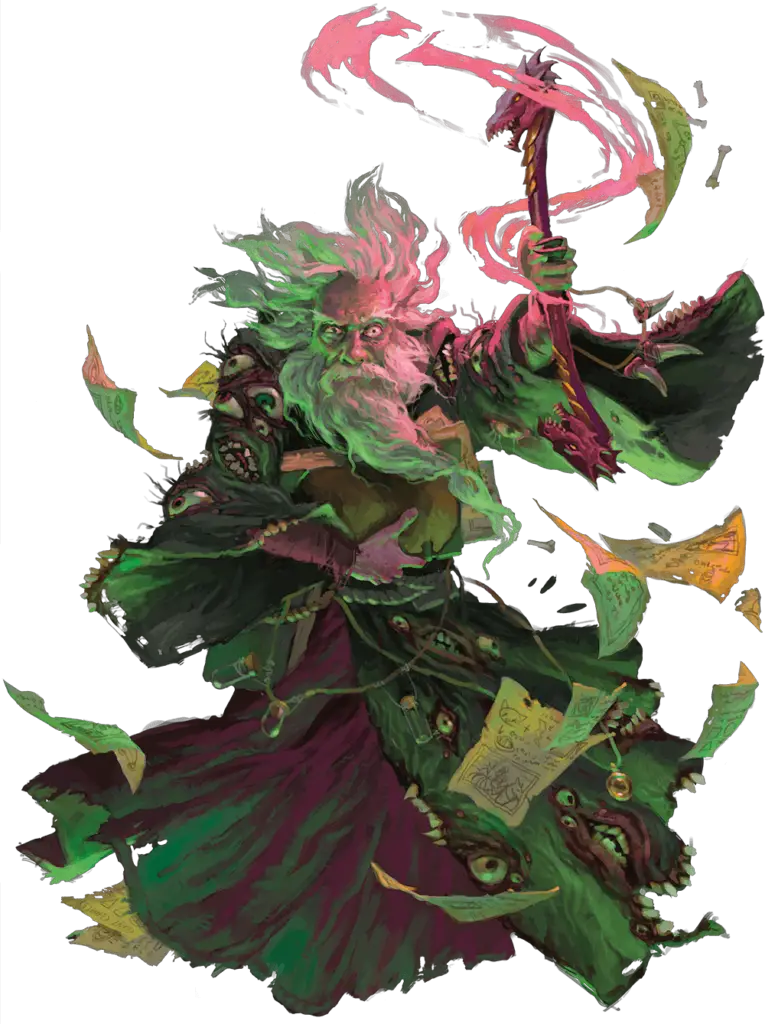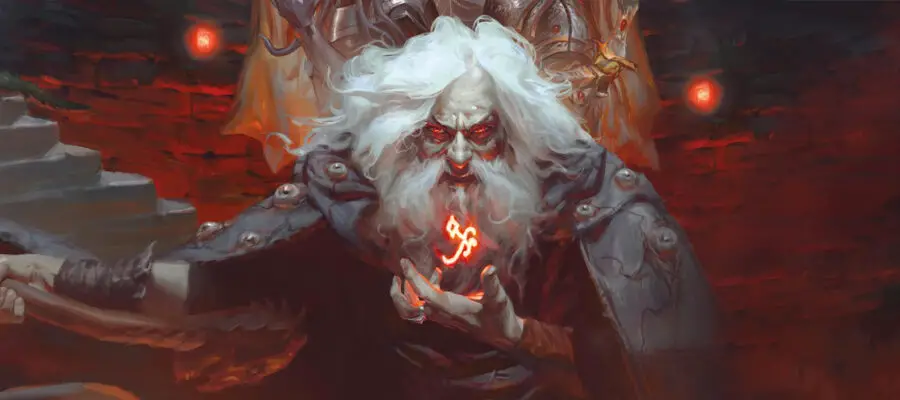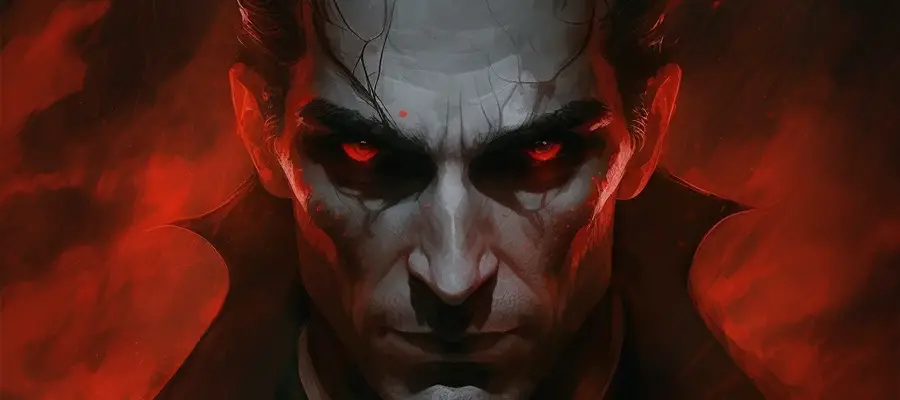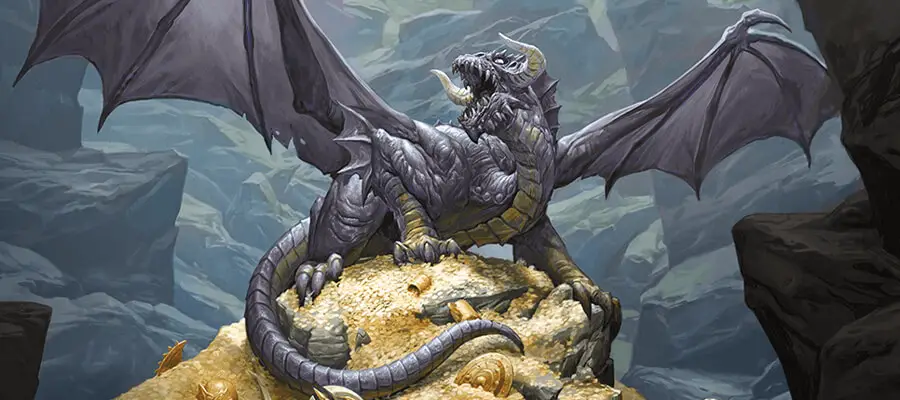Sanity D&D 5e art for this article is licensed to Wizards of the Coast from the Waterdeep: Dungeon of the Mad Mage manual. This article contains affiliate links that add gold to our coffers at no expense to our reader. Consider clicking our affiliate links to support our small business so that we can continue to bring valuable resources to you.
While an adventurer may be more resilient to the burdens of constant danger than the average person, no sentient humanoid is immune to the effects of stress, especially over long periods of time. Whether a character must deal with the creeping influence of anxiety or the trauma of watching a person die suddenly, any number of psychoses can and possibly should be explored in tabletop roleplaying games.
In Dungeons & Dragons 5e, the Dungeon Master’s Guide provides rules for madness and sanity that leave a lot lacking. In a game where shell shock is as equally likely as magical curses, the rules following page 258 are both ambiguous in their application and inapplicable across the board. Additionally, while mental health is an issue players may wish to explore in the safer environment of D&D, the rules as written in the DMG offer neither sufficient flexibility nor satisfactory guidance.
In this article, I’ll briefly explain the rules for Insanity as found in the Dungeon Master’s Guide, then build upon that foundation with detailed ideas and mechanics for incorporating mental health, from trauma response to hysteria to madness. I’ll use examples from similar TTRPG games such as Call of Cthulhu, Darkest Dungeon, and more, to set the stage for successfully incorporating insanity into D&D 5e.
Benefits of Including Sanity in Gameplay
As I’ll describe below, Sanity has a wide array of possibilities as a gameplay mechanic. But more importantly, Sanity encourages and coaches players into responding to in-game events and stressors in a way I’ve yet to encounter in Dungeons & Dragons.
As a Dungeon Master, there’s no disappointment like creating a scenario of horror or trauma, only to be met with a lack of response or in-game character development. This really isn’t the fault of the players, most of the time, as they often don’t know how to respond to such events, especially if they are not keen on heavy roleplaying.
Incorporating Sanity as a mechanic helps players lean into trauma as well as develop the flaws of their characters, which results in richer roleplay. With the alternative rules that I provide below, players will be enabled to find ways to respond to traumatic events in-game without the burden of extreme mechanical alteration unless desired.
Rules for Madness in D&D 5e
In 5th edition, madness can befall a character from stress of the psyche, malevolent spellcasting, contact with eldritch horrors, cursed magic items, illness and disease, planar winds, hexes, curses, or other magical effects. These repercussions can be interim or indefinite, but most madness can be cured or healed.
DMG pg. 259:
“A character afflicted with short-term madness is subjected to an effect from the Short-Term Madness table for 1d10 minutes.
A character afflicted with long-term madness is subjected to an effect from the Long-Term Madness table for 1d10 x 10 hours.
A character afflicted with indefinite madness gains a new character flaw from the Indefinite Madness table that lasts until cured.”
“A calm emotions spell can suppress the effects of madness, while a lesser restoration spell can rid a character of a short-term or long-term madness. Depending on the source of the madness, remove curse or dispel evil might also prove effective. A greater restoration spell or more powerful magic is required to rid a character of indefinite madness.”
Tables can be found for Short-Term Madness, Long-Term Madness, or Indefinite Madness on the DMG pg. 259-260. However, I do not recommend a DM use these tables for players to roll for random effects, as the scopes of the effects are vast and possibly detrimental in ways that may not make sense in-game. These tables are best as effects for curses or the result of encountering unfathomable eldritch terrors and truths or unthinkable torment, like what you’d find in a horror campaign such as Curse of Strahd.
For example, on the Short-Term Madness Table, a player may be forced to attack the nearest creature, friend, or foe. Or, they could simply fall unconscious. These effects last 1-10 minutes, which may take a character out of an entire combat experience. Again, this is not ideal. I have a fix for this below, so stay tuned.
Sanity as an Ability Score
Mechanically, the DMG suggests players add an additional ability score: Sanity. Much like with the other ability scores such as Strength and Charisma, players will determine their Sanity score by either using the standard array, point-buy system, or rolling method.
DMG pg. 264:
- If your players use the standard array of ability scores, add one 11 to the array for each optional
- ability you add.
- If your players use the optional point-buy system, add 3 points to the number of points for each optional ability you add.
- If your players roll their ability scores, have them roll for the added ability scores.
“If you ever need to make a check or saving throw for Honor or Sanity for a monster that lacks the score, you can use […] Wisdom for Sanity.”
Sanity as an ability score can be used for saving throws, to recall information about history, to comprehend alien language and magic, or to overcome the effects of madness.
Using Sanity as an ability score is the method I recommend, whether your characters are engaged in the horror genre or developing character through trauma response. As a skill, Sanity can be strengthened by leveling up (ASI or potential feats) or penalized by hexes, cursed items, exhaustion, or other means.
Implementing Mechanics of Sanity

Let’s explore establishing rules for Sanity as an ability score, as per the Dungeon Master Guide, with modifications inspired by former editions of Dungeons & Dragons and other tabletop roleplaying games.
Add Sanity as an additional ability score, incorporating this into the stats as described in the section above. Players may choose to be proficient in the Sanity saving throw if this makes sense for their class or race build.
Alternatively, the Intelligence stat may be used in place of a new ability score. Utilize the following mechanics with either a Sanity ability or with the existing Intelligence ability.
In certain spells, such as Contact Other Plane, which requires an Intelligence DC 15 saving throw less you take psychic damage, the Intelligence save may be replaced with a Sanity save, or perhaps both rolls are required separately: Intelligence for the damage and Sanity for a lingering stress effect (see table below).
Spells that may require a Sanity saving throw:
- Compulsion
- Confusion
- Contact Other Plane
- Crown of Madness
- Dissonant Whispers
- Divine Word
- Eyebite
- Fear
- Feeblemind
- Glyphs of Warding
- Otto’s Irresistible Dance
- Phantasmal Force
- Phantasmal Killer
- Tasha’s Hideous Laughter
- Weird
Certain in-game events and effects may require players to make Sanity saving throws as well. Dungeon Masters may determine their own DC as fit for the event, or they may utilize the table below as a baseline.
Note that many of these events may relate to roleplaying or backstory situations. As such, the effects of failing a Sanity saving throw at first are minor. As the trauma builds up, the effects become direr. This will be explored in the next section.
Sanity Saving Throws: Events and DC
When a traumatic event occurs, similar to what is listed below, a Dungeon Master may have their players roll a Sanity or Intelligence check. Increase the following DC for situations direr than their corresponding events in the table.
Based on the backstory or history of a particular character, a Dungeon Master may wish to impose disadvantage on a Sanity check.
| Event | Sanity DC |
|---|---|
| Regretting a major choice | 8 |
| Studying the works of a lunatic | 8 |
| Recalling horrific events or knowledge | 8 |
| Witnessing the death of an innocent person | 10 |
| Being tortured | 10 |
| Having extremely graphic nightmares | 10 |
| Encountering a gargantuan-sized beast or monster | 10 |
| Engaging with a hostile fey or elemental being | 10 |
| Being surprised in battle | 10 |
| Being trapped in a small space | 10 |
| Suffering severe shock, physiologically or mentally | 11 |
| Torturing another creature or person | 11 |
| Fear in battle | 11 |
| Being banished or teleported to a new realm | 11 |
| Becoming maimed or disfigured | 12 |
| Reading text from an eldritch language | 12 |
| Shell-shock from battle or explosions, including magical | 12 |
| Experiencing the death or maiment of someone you care about | 12 |
| Realizing you have a modified memory | 12 |
| Being haunted by a monster such as a night hag or ghost | 12 |
| Encountering a mind-bending monster | 13 |
| Casting a harmful spell on an innocent target | 13 |
| Hearing an eldritch entity speak | 14 |
| Finding a gruesome scene | 14 |
| Discovering forbidden or ancient arcane knowledge | 14 |
| Encountering a personal phobia | 14 |
| Learning spells or secrets of a forbidden tome | 15 |
| Experiencing a supernatural situation (involving deities or aberrations) | 15 |
| Witnessing the death of a party member in a gruesome or horrific manner | 16 |
Failing Sanity Checks: Stress Effects
If a player fails a Sanity (or Intelligence) check, a Dungeon Master should determine how dire the situation and result are. For situations with minor stress effects, such as regretting a choice or having extreme nightmares, Dungeon Masters may opt to select or roll for a minor stress effect (see below). For situations involving high stressors or magical effects, a major stress effect may be more appropriate. Characters who suffer from multiple unresolved minor stressors may gain a major stress effect or be penalized by rolling future Sanity checks with disadvantage.
For higher-risk games, choose or roll directly on the Major Stress Effect table when failing a Sanity (or intelligence) check.
The Effects of Exhaustion on Sanity
It’s apparent to many that one’s physical well-being greatly affects one’s mental health. A player who has taken a level of exhaustion may need to roll for a minor stressor. If multiple levels of exhaustion are granted, or multiple stressors in combination with exhaustion, a Dungeon Master may rule that a character takes a major stress effect.
I recommend the following rule: if the number of minor stressors summed with the level of exhaustion a player has is greater than a character’s Wisdom modifier (or proficiency bonus, chosen by the Dungeon Master), the character must roll for a major stress effect.
Minor Stress Effects
Note that minor stress effects typically involve roleplay and character development and do not usually penalize stats and mechanics. However, a Dungeon Master may wish to impose stat-based fallout. Optional mechanical effects will be included in the table below.
Minor stress effects can be seen more as “flaws” than game-changing afflictions and can be resolved over time with personal work in downtime or from seeking cures and help. Details of these healing methods can be found in further sections.
Additionally, a DM may wish to look through the “Indefinite Madness” table on page 260 for more flaws to incorporate.
Some of the optional mechanical consequences involve the discretion of the DM. For instance, if a player encounters a half-elf who reminds them of a cultist who tortured them, the character would likely mistrust that half-elf and suffer from bad judgment as a result. These details are entirely up to the Dungeon Master but may provide depth to social encounters and character development.
| d20 | Minor Stress Effect | Optional Mechanical Consequences |
|---|---|---|
| 1-2 | You alter or hide your memories to shield yourself from further pain. | You have disadvantage on History checks when recalling facts related to the event. |
| 3-4 | You develop a slight phobia of a minor detail related to the event (avoidance of pain, caution near water, discomfort in crowds, startle at loud noises, sickness at the smell of iron, etc). | When you act contrary to your phobia, you must make a Sanity check DC 13. On a failed save, you receive a major stress effect. |
| 5-6 | You sometimes feel like you see movement in the shadows without plausible reason. | When you experience a situation reminiscent of the event (at the discretion of the DM), you gain disadvantage to Wisdom (Perception) checks. |
| 7-8 | You find yourself distrusting new people more than usual if they somehow remind you of the event. | When encountering an individual reminiscent of the event (at the discretion of the DM), you gain disadvantage to Wisdom (Insight) checks against that target. |
| 9-10 | At times, you babble rapidly to yourself under your breath. | When making a Charisma (Persuasion) check, if your target has witnessed you babbling in the last hour, the challenge DC increases by 2. |
| 11-12 | You develop a nervous twitch when in high-stress situations. | When in high-stress situations similar to the event, you receive a -1 penalty to Dexterity (Stealth) rolls. |
| 13-14 | You find it easier to believe false comforting truths, particularly explaining the reason why the event may have happened. | When told details relating to the event or similar events, you gain disadvantage on Wisdom (Insight) checks in discerning truths on the subject or motives of the speaker. |
| 15-16 | You become fixated on a detail of the event and strive to unravel the mysteries therein. | Explaining a detail in the event becomes one of your goals. You spend at least half of your downtime researching or thinking about the unanswered questions related to the event. |
| 17-18 | You feel inadequate compared to your adventuring companions, as if you let them down because of how the event has affected you. | You no longer benefit from the spells Bless or Guidance. |
| 19-20 | The event replays in your mind often, and you find it difficult to focus at times. | When rolling for initiative, you have a -1 penalty to your roll. |
Major Stress Effects
Unlike minor stressors, major stress effects alter a character’s stats and abilities. These effects should be reserved for high-dread campaigns where long-lasting trauma and peril are expected. Additionally, major stress effects can occur when a character gains too many minor stress effects equal to their Sanity modifier plus their proficiency bonus.
For instance, a character who has a Sanity score of 13 at level 2 can only handle 3 minor stressors before becoming burdened with a major stress effect.
These major stressors are not game-breaking but certainly have mechanical consequences. For more dire mechanical effects, consider rolling or selecting from the Short-Term Madness table in the Dungeon Master’s Guide pg. 259.
| d20 | Major Stress Effect | Mechanical Consequences |
|---|---|---|
| 1-2 | You freeze up when battles begin. | You have disadvantage on all Initiative rolls. |
| 3-4 | You distrust others, even close friends. | You cannot benefit from the Help action. |
| 5-6 | You panic in high-stress situations. | You have disadvantage on all Dexterity (Stealth) checks. |
| 7-8 | You suffer from hallucinations and therefore cannot trust your own senses. You can decide if you are aware that these are hallucinations or not. | You have disadvantage on all Wisdom (Perception) checks. |
| 9-10 | Your fixation on the event causes major self-doubt. | You can no longer gain Inspiration. |
| 11-12 | You find it hard to peacefully rest at times. | Your maximum number of hit dice are reduced by 1 to a minimum of 1. |
| 13-14 | Stress has taken a physical toll on your body. | Your maximum hit points have been reduced by 2 times your Proficiency Bonus. |
| 15-16 | You frequently suffer from shortness of breath as a result of panic attacks. | Each of your movement speeds are reduced by 5 feet. |
| 17-18 | You find it difficult to eat, as the stress has reduced your appetite. | You have disadvantage on Constitution saving throws. |
| 19-20 | You find it hard to bond with magical items. | The maximum number of magic items you can attune to reduces by 1. |
Resolving Stressors
Characters burdened by stressors, minor or major, may find solace that there are ways to resolve these effects. Based on character backstory, campaign details, and discretion of the Dungeon Master, a player may rid themselves of their stressors using the following methods:
Blessings of a Priest or Spiritual Shaman
If a character serves a particular deity, they may spend four to eight non-consecutive hours working through their trauma with a priest or shaman of the deity they serve, either through ritual, spellcasting, discussion, therapy, prayer, or any combination of these options. At the end of the four hours, one minor stressor may be removed. At the end of the eight hours, one major stressor may be resolved.
A Dungeon Master may decide that a light or hefty tithe is required to pay for components and services rendered by the priest or shaman. My default is 50 to 100 gp, but if your campaign proffers a high gold reward, a larger sacrifice may be needed.
Meditation
Using downtime, a player may find peace through meditation. A character must spend one day (eight non-consecutive hours) of downtime per week to counteract a minor stressor and two days to negate the effects of a major stressor.
Medication
A character may purchase or craft special potions to keep the symptoms of stress at bay. Use the rules for Brewing Potions of Healing as found in Xanathar’s Guide to Everything. One common potion of healing will need to be taken each week to counter the effects of stress until a long-term solution is found. Alternatively, a potion of Greater Healing may be taken once per month to achieve the same result.
Feat for Sanity
Comforting Words
- Increase your Sanity ability score by 1, to a maximum of 20.
- Once per long rest, immediately before any creature within 30 feet of you makes a Sanity saving throw, you may speak words of solace that relieve some of the horrors they experience. Each creature of your choice that can hear you within range, including yourself, gains advantage on the Sanity saving throw.
- You gain proficiency in Sanity saving throws.
Conclusion
Sanity is an optional mechanic often dismissed as either extreme or useless in D&D 5e. However, using Sanity as an additional ability score has a wide array of uses and benefits. By implementing more Sanity checks, balanced by minor and major stress events, a Dungeon Master can coach their players to roleplay trauma and horror more successfully.
How have you used Sanity in your gameplay? Start a discussion below and let us know!




